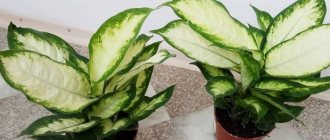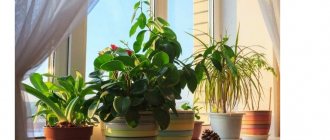Plants in the house should be safe for everyone who lives in it.
Home is a comfortable and safe place for all family members. You need to remember this every time you buy something for the interior, including indoor plants. If there are small children in the house, the issue of safety becomes doubly relevant.
Plants that should not be placed in the nursery
Plants with poisonous juice that irritates the skin and mucous membranes should not be placed in a nursery.
These include:
- Dieffenbachia,
- Yucca,
- Monstera,
- Alocasia,
- Oleander,
- Ekhmeya,
- Spurge,
- Ficuses.
It is not recommended to place plants with thorns or thorns that can harm the physical body in nurseries with children under 14 years of age:
- cacti,
- aloe.
There is no need to place the following plants:
- Emitting a strong aroma that makes your head hurt.
- Causing allergic reactions.
- Do not place plants with bright, appetizing but poisonous fruits, such as nightshade.
- Plants that are difficult to care for and cannot be moved or rotated frequently.
- Very fragile plants that break quickly.
TOP 12 best plants for a child's room
Flowers in the nursery will purify the air and add vitality to the interior.
The list of flowers that are useful and safe for the health of a boy or girl includes diverse plants - ampelous and erect, low-growing and tall, decorative-flowering and decorative-deciduous.
Sansevieria
One of the most unpretentious crops is Sansevieria, or mother-in-law's tongue. Its beauty lies in its dense, sword-shaped leaves, collected in dense rosettes. From several varieties of mother-in-law's tongue you can create multi-level and multi-colored compositions that will certainly become the center of attention.
Sansevieria does not need high air humidity and regular spraying
The main conditions for care are careful watering, fertilizing in the warm season and periodically wiping the leaves from dust.
People also call this flower “mother-in-law’s tongue” and “pike tail”
Lemon Tree
You can grow any citrus tree yourself by sowing a seed from a store-bought fruit in a pot. A lemon, tangerine or orange tree will be the best decoration for a child's room. Over time, the exotic plant will turn into a pretty tree, and under optimal conditions, it will bloom and bear fruit.
The leaves of the lemon tree saturate the air with essential oils, which have bactericidal properties and kill pathogenic viruses and microbes. The child will be interested in watching the growth and development of citrus.
With proper care, a lemon tree can even bear fruit.
Kalanchoe
You can put any variety of Kalanchoe in the children's room. All representatives of this numerous genus have the ability to purify the air of bacteria, stop bleeding and accelerate wound healing:
- Kalanchoe Blossfeld with minimal care will delight you with bright inflorescences of red, yellow or orange color;
- Kalanchoe Pinnate will help cure a runny nose if necessary;
- Kalanchoe Laciniata, or deer antlers, will decorate the room with carved leaves, cut into several fragments.
Kalanchoes are hypoallergenic, unpretentious and do not require special care.
Chlorophytum
Chlorophytum is the best purifier for home air saturated with dust, harmful chemical compounds and dangerous bacteria. Its leaves are capable of collecting up to 80% of toxins and pathogens hovering in the immediate vicinity of the pot in a day. Chlorophytum tolerates dry apartment air well and grows actively both in the sun and in the shade. Several pots of chlorophytum will enliven the children's room with long flower stalks and lush “fountains” of greenery.
One of the most useful indoor plants is chlorophytum.
Violet
Violets are an ideal choice for a girl's room. They are non-toxic, unpretentious and feel great even on northern windows. A huge number of Saintpaulias with different colors and shapes of leaves and buds allows you to create an original flower arrangement. By placing pots with different varieties on the window, you can admire the blooming violets all year round.
You can grow a violet from just one leaf
Cypress
Cypress is similar in shape to a miniature Christmas tree, but, unlike it, it has soft, scale-like needles. This tree is called a green vacuum cleaner for its ability to accumulate dust, harmful substances and bacteria floating in the air on the surface of its branches. In order for the flower to effectively cope with this task, it is recommended to bathe it regularly in the shower. Cypress saturates the air with phytoncides that are beneficial for the respiratory system (especially for children suffering from frequent bronchitis and bronchial asthma).
Cypress perfectly purifies the air
Decembrist
Decembrist belongs to the genus of forest cacti that do not have thorns.
Christmas cactus (Schlumbergera) in pot
Its segmented leaves are attached to each other, forming a dense, lush bush. It usually blooms in winter before the New Year holidays, covered with numerous buds of white, red, pink or crimson.
To prevent the blooming Decembrist from dropping its flowers, from the moment the buds appear, you cannot turn the pot relative to the cardinal directions or move it to another place.
Begonia
Begonia has the property of releasing essential oils into the air that are beneficial for the respiratory system. For a baby, proximity to such a flower will be beneficial not only from a medical, but also from an aesthetic point of view. Decorative flowering begonia varieties will delight you with lush inflorescences, and decorative deciduous varieties will delight you with unusual patterns on the leaves.
Begonia releases beneficial essential oils into the air
Hibiscus
The indoor hibiscus, or Chinese rose, attracts the eye with its shiny foliage and brightly colored buds that are odorless. A young specimen that does not take up much space is suitable for a children's room. When the bush grows to an impressive size, it can be moved to the living room - the hibiscus will look impressive in any part of the house.
Hibiscus can grow to large sizes, so it needs to be trimmed
Tradescantia
To create a green corner in the nursery, you can use hanging tradescantia. It grows quickly and in 2-3 months turns from several small cuttings into a gorgeous plant. Tradescantia has an attractive color: the most common varieties are those whose leaves are covered with green, white and purple stripes. The climbing beauty will grow well in brightly lit windows and on the north side of the house.
Tradescantia has one drawback - it grows quickly
Peperomia
Of all the varieties of peperomia for a child's room, it is better to choose a dull-leaved or cluse-leaved variety. They are able to accumulate water reserves in the stems and leaves, so they do not need frequent watering, spraying or high humidity. According to experienced gardeners, you need to try very hard to ruin peperomia: it will be able to adapt to both the lack of light and direct sunlight.
Only 50 types of peperomia can be grown at home
Spathiphyllum
The flower of happiness or women's happiness is what people call spathiphyllum. Its shiny foliage looks spectacular both on its own and in combination with other indoor plants.
This flower is also called “women’s happiness”; it is believed that its flowering portends joy
Spathiphyllum cleanses and humidifies the air well, evaporating moisture through its numerous leaves. The appearance of flower stalks is considered a good omen, promising mutual understanding between spouses, as well as between children and parents.
Don't try to fill a child's room with a lot of pots. It is enough to place 2-3 large specimens or 3-4 small plants in it. Otherwise, at night, when the flowers begin to actively release carbon dioxide, the child may suffer from a lack of oxygen.
Planting currants in 2022: favorable days, when to plant, care calendar
22 Feb 2022 0
Currants are a popular garden crop with delicious berries,…
More details
Useful tips
Decembrist (Schlumbergera)
Another long-known plant is Schlumbergera, or Decembrist, also known as the Christmas cactus. These names are due to the fact that this culture blooms just in the midst of winter, for the holidays. Decembrist prefers partial shade, coolness and rare watering (except during the flowering period), i.e. could be an ideal first plant for a child.
It is believed that the Decembrist helps to cope with negative energy in the house, and it is best to place it next to the sleeping place. Believe it or not, decide for yourself, but extra oxygen in the nursery definitely won’t hurt.
Feeding peppers after planting in open ground: the most effective and best means
22 Feb 2022 0
To get a good harvest of peppers, the plants are fed…
More details
Tubers
Why indoor flowers?
Vegetation in a residential building performs several functions at once:
- interior decoration - free-standing flower pots themselves add some freshness to the interior, and well-created compositions make the room more comfortable;
- air filtration (purification) - thanks to the ability of plants to absorb carbon dioxide and release oxygen, the air in the room becomes cleaner. Also, some representatives of the flora are able to purify the air from house dust, which is very important for allergy sufferers;
- disinfection - some types of plants have an antibacterial effect and purify the air from pathogens;
- calming effect - some types of indoor plants have a calming effect;
- medicinal - there are indoor plants (such as aloe, golden mustache, etc.) that have healing properties;
- noise absorption - flower compositions can create special noise insulation in a room. It is especially good to use plants with large large leaves for this;
- distraction - in some cases, indoor flowers can be used to “disguise” defects on the wall, protruding wires, etc.
Children learn to take care of nature
In addition to the above for children, especially older preschool and school age, indoor flowers are needed for education:
- knowledge of the world - study of leaves, shoots, inflorescences, etc.;
- learn to care for plants (plant, water, spray, etc.);
- In the process of caring for plants, the child is instilled with a love of nature and a responsible attitude.
Children and indoor plants
Note: If a family does not have a summer house or a plot of land where the child can be directly “introduced” to nature and caring for plants, then indoor unpretentious flowers in the apartment are an excellent solution.
Planting pepper seedlings in open ground in 2022: when to plant, timing
21 Feb 2022 0
Pepper is a heat-loving crop, demanding on climatic conditions....
More details
Pumpkin
Lemon or orange tree
For anyone who wants to choose an unusual plant for a nursery (and is confident in their child’s endurance), numerous citrus fruits will come to the rescue. Tangerine, lemon, orange, kumquat and other trees are adapted for growing in large pots, love warmth and can decorate any home.
In addition to the natural aromatherapy that they guarantee to their owners, trees can also please you with their harvest. Of course, it’s not easy to get a richly fruiting orange in an apartment, but you can try with a kumquat or lemon - the child will be delighted.
Sowing cucumbers in March 2022: when to plant, timing
21 Feb 2022 0
Cucumbers are the undisputed leaders in garden beds. Almost every…
More details
Trees and shrubs
Begonia
Indoor plants for a nursery should stand the test of time, and begonia fits this criterion perfectly. Of course, it stood on our grandmothers’ windows for decades and pleased us not only with its appearance, but also with its useful properties. Due to the high content of essential oils, begonia serves as a kind of filter that cleans and disinfects the air.
The plant will feel best on a south-facing window with moderate watering. If you want begonia to bloom regularly, do not spray it, protect it from drafts and do not forget about complex mineral fertilizers.
Peperomia
The unusual appearance of peperomia flowers, its excellent filtering properties and unpretentiousness have made this plant a frequent guest in children's rooms. There are many varieties of peperomia on the market, and you can choose the one that your child will like.
Although the culture is unpretentious and grows equally successfully on any window without additional lighting, do not forget about regular watering and spraying. And if you want to see flowering, add a portion of fertilizer for indoor plants to the pot once a quarter.
Bouquets for boys and girls
The gender of the child must be taken into account, but only if his gender is important to the little person. If the age of a boy or girl is very young, then gender can be ignored as a guideline for choosing a bouquet. It is much more important to take this moment into account at an older age. And you especially need to remember this when choosing colors for teenagers.
What flowers should I give a boy? Those that are considered masculine:
- Carnations and irises;
- Cornflowers and dark roses;
- Exotic, strict in their lines options.
For girls - tulips, pink, white, other, but not dark shades of rose, other flowers, the colors of which are considered feminine.
In addition to bouquets of flowers, girls and boys can safely give flower toys. These are charming compositions that children of any age enjoy. After all, toys are childhood itself, regardless of what they are made of.
Violet (saintpaulia)
Perhaps the most frequent visitor to our window sills is the violet. White, pink, beige, purple, salmon flowers of regular and double shapes will not leave anyone indifferent. In addition, violets are inexpensive, and from different varieties you can organize a whole garden for a young naturalist.
Fluffy violet leaves take root well, so you can propagate the flower and exchange with friends. It is only important to convey to the child that the violet does not like abundant watering, and it is not worth grabbing its fluffy leaves again.











